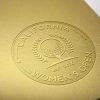
Choosing the right colors for a logo may seem like a simple task, but trust us, it’s a job best left to the experts. Picture this: you’re trying to create a brand that stands out in a sea of competitors, but instead, your logo ends up blending in like a chameleon at a paint store. Fear not, dear readers, for we are here to reveal the secrets behind mastering color choice in logo design – and the psychological trickery that goes into effective branding. So grab your color wheel and buckle up, because we’re about to take you on a wild ride through the rainbow of branding brilliance.
Understanding the basics of color theory
So you think you know color theory, huh? Well buckle up, because we’re about to dive into the colorful world of hues, shades, and tones! Here are some basics to help you wrap your head around the wonderful world of colors:
When it comes to color theory, there are a few key concepts you need to understand:
- Primary Colors: These are blue, red, and yellow. They’re like the OGs of the color wheel – all other colors are created by mixing these bad boys together.
- Secondary Colors: When you mix two primary colors together, you get a secondary color. Think green, purple, and orange – these babies are created through the magic of color mixing.
- Complementary Colors: These are colors that are opposite each other on the color wheel. They’re like peanut butter and jelly – they just go together so perfectly.
But wait, there’s more! Ever heard of warm and cool colors? It’s like the ultimate battle of nature - warm colors like red, orange, and yellow bring the heat, while cool colors like blue, purple, and green are cool as a cucumber. And let’s not forget about neutrals – the unsung heroes of the color world. They may not be as flashy as the rest, but they definitely have their place in the color spectrum.

The impact of color on consumer behavior
Color is a powerful tool that marketers use to influence consumer behavior. It can evoke emotions, create associations, and even alter perceptions. Let’s dive into the fascinating world of how color affects what we buy and why we buy it.
Here are some examples of how different colors can impact consumer behavior:
- Red: A bold and attention-grabbing color, red is often used to create a sense of urgency. It can make consumers feel excited and eager to make a purchase.
- Blue: Blue is a calming and trustworthy color. It is often used by brands to build trust with consumers and convey reliability and professionalism.
- Yellow: A cheerful and optimistic color, yellow can evoke feelings of happiness and positivity. It is often used to grab attention and create a sense of urgency.
It’s no surprise that companies spend a lot of time and money researching the psychology of color. By using the right colors in their branding and marketing materials, they can influence our perceptions and choices without us even realizing it. So next time you’re drawn to a product on the shelf, take a moment to consider the impact that color may be having on your decision-making process.
![]()
Choosing the right colors for your brand
When it comes to , it’s not just about what looks good. You want to evoke a certain feeling, create a specific vibe, and stand out from the competition. Here are some tips for selecting the perfect palette:
First and foremost, think about your target audience. Are they young and hip? Maybe go bold with bright, vibrant colors. Are they more mature and sophisticated? Opt for elegant neutrals with a pop of color. Knowing who you’re trying to attract can help guide your color choices.
Consider the psychology of color. Red can make people hungry (hello, fast food chains!), blue is calming and trustworthy, and yellow can bring a feeling of happiness. Choose colors that reflect the emotions you want associated with your brand.
Don’t be afraid to get a little crazy! Mix and match colors until you find the perfect combination that makes your brand pop. And remember, you can always change things up if it’s not working out. After all, it’s just paint on a canvas, not a permanent tattoo!

Using color to evoke emotions and create associations
Color plays a crucial role in evoking emotions and creating associations. We’ve all heard of the classic color associations – like red for passion and love, or blue for calmness and tranquility. But did you know that colors can also be used to manipulate emotions and perceptions?
Imagine walking into a room painted in bold, fiery reds and oranges. You may start to feel a sense of energy and excitement, almost like you’ve just downed a gallon of coffee. Now, picture that same room painted in serene blues and greens. Suddenly, you feel calm and relaxed, like you’re floating on a cloud. It’s amazing how colors can have such a profound impact on our mood!
By strategically incorporating different colors into your environment, you can influence how people feel and behave. Want to create a cozy, inviting atmosphere in your home? Try using warm hues like oranges, yellows, and browns. Looking to spark creativity and inspiration in your workspace? Opt for cooler tones like blues, greens, and purples. The possibilities are endless!
So, the next time you’re feeling blue (pun intended), consider adding a pop of color to your surroundings. Whether you’re looking to boost your mood, enhance your creativity, or simply make a bold statement, harnessing the power of color is a surefire way to evoke emotions and create lasting associations.

The psychology of color in logo design
Have you ever looked at a logo and felt a sudden urge to buy the product simply because of the colors used? That’s the magic of color psychology in logo design! Let’s dive into the fascinating world of colors and how they play a crucial role in shaping consumer behavior.
Here’s a fun fact: did you know that the color blue is often associated with trust and reliability? That’s why you see so many banks and tech companies using this calming hue in their logos. It’s like saying, “Hey, we may not have your money, but you can trust us with it!”
On the other hand, if you see a logo splashed with vibrant red or orange hues, chances are you’re looking at a brand that wants to grab your attention and make you feel hungry. It’s like they’re saying, “Forget your diet and come indulge in our tasty offerings! We promise, your waistline won’t mind.”
So, the next time you’re designing a logo, remember the power of colors in influencing consumer perception. Whether you want to exude sophistication with black and gold, or create a sense of playfulness with bright rainbow colors, the psychology of color is your trusty sidekick in logo design!
Establishing a strong brand identity through color
When it comes to establishing a strong brand identity, color plays a crucial role. Your choice of colors can make or break how customers perceive your brand. Let’s dive into how you can use color to create a lasting impression on your target audience.
First and foremost, **consistency** is key. You want to choose a color palette that reflects your brand’s values and personality and stick with it across all your marketing materials. Whether it’s your website, social media profiles, or promotional materials, make sure your brand colors are front and center.
Next, consider the **psychology** behind colors. Different colors evoke different emotions – red can convey passion and excitement, while blue may bring a sense of trust and reliability. Make sure to choose colors that align with the message you want to convey to your audience.
Lastly, don’t be afraid to **experiment** with different shades and hues. Your brand colors don’t have to be set in stone. As trends change and your brand evolves, feel free to refresh your color palette to keep things fresh and engaging for your customers.
Maximizing the effectiveness of your logo with strategic color choices
So, you’ve got a logo, huh? Good for you! But do you know how to make it really pop? Let’s dive into the wonderful world of strategic color choices and maximize the effectiveness of that bad boy!
First things first, consider the psychology of colors. Different colors evoke different emotions and responses, so choose wisely. Red: Bold and attention-grabbing. Blue: Trustworthy and calming. Yellow: Optimistic and cheerful. Pick a color that aligns with the message you want to convey.
Next, think about your target audience. What do they respond to? What colors resonate with them? Cater your color choices to appeal to your target demographic. For example, if you’re targeting a younger crowd, vibrant and energetic colors may be the way to go.
Don’t be afraid to experiment with different color combinations. Sometimes unexpected pairings can create a memorable and impactful logo. Test out different options and see what works best for your brand. And remember, there’s no harm in seeking professional help if you’re feeling stuck. A graphic designer can provide valuable insights and expertise to help you nail down the perfect color scheme.
FAQs
Why is color choice in logo design so important?
Well, would you want to eat a hot pink hamburger? Probably not. Color plays a huge role in how we perceive a brand, so picking the right colors can make or break your logo design.
How do different colors evoke different emotions?
Think of colors like little mood rings for your brand. For example, red can make people feel excited or hungry (or both if you’re running a fast-food joint), while blue can make them feel calm and trustwothy (just like a soothing hug from your logo).
Can using the wrong colors in a logo design hurt a brand?
Absolutely! Imagine if McDonald’s swapped their golden arches for a sickly green color—it just wouldn’t have the same appetizing appeal. Using the wrong colors can confuse customers and even turn them off from your brand entirely.
How can businesses use color psychology to their advantage in logo design?
By understanding the emotions that different colors evoke, businesses can strategically choose colors that align with their brand message. Want to come across as trustworthy? Go for blue. Want to stand out from the crowd? Opt for a bold red or yellow.
Any tips for mastering color choice in logo design?
When in doubt, keep it simple. Don’t throw every color of the rainbow into your logo design—pick a few key colors that best represent your brand. And always test your logo with different color palettes to see which one resonates best with your target audience.
In Conclusion: Unleash Your True Color Superpowers!
Well, dear reader, you have now completed your crash course in the mysterious world of color psychology in logo design. Armed with this knowledge, you are now equipped to create logos that not only look visually appealing but also speak directly to your target audience on a psychological level.
So go forth, future branding wizards, and unleash your true color superpowers! Remember, with great color choice comes great branding responsibility. And who knows, maybe one day your logo will be heralded as the ultimate symbol of consumer enlightenment. Good luck, and may the colors be ever in your favor!











